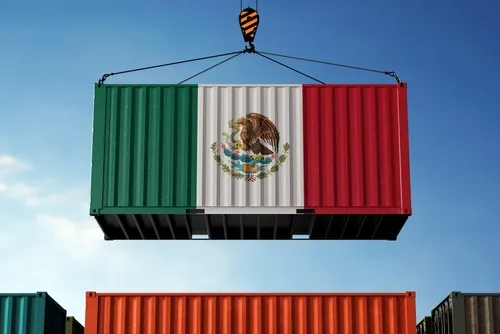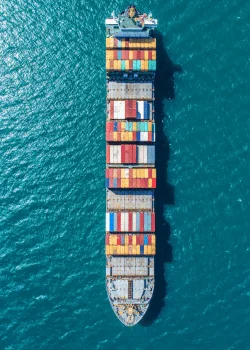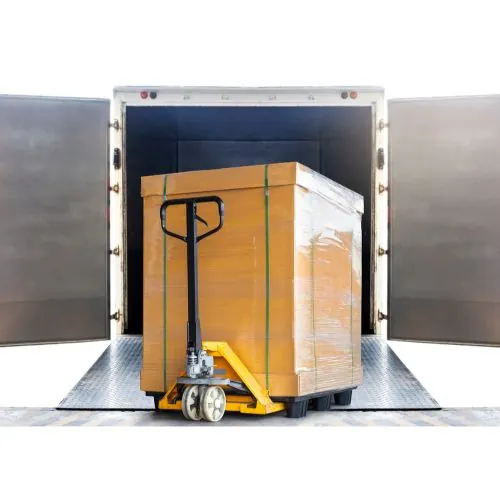
Mexico
When it comes to cross-border shipping between the United States and Mexico, businesses and shippers need to be well-prepared to handle a complex system of regulations, paperwork, and logistics.
Cross-border shipping has become increasingly essential due to the growing trade relationships between the two countries. FreightCenter, as a logistics provider, aims to simplify the process and offer insights into how best to navigate this intricate area of supply chain management.
In this guide, we will cover everything you need to know about cross-border shipping to Mexico, from understanding regulations to managing costs and optimizing efficiency. The following sections will dive deep into the details of the shipping process, from preparation to delivery, along with tips for overcoming common challenges.
Understanding Mexico Cross Border Shipping
Cross-border shipping involves the transportation of goods between two countries. In the case of the U.S. and Mexico, this includes not only navigating the physical logistics of moving goods from point A to point B but also ensuring compliance with various laws and customs procedures. The goal is to make the process as smooth and efficient as possible while reducing delays and extra costs.
The U.S. and Mexico share a long land border, making freight transportation by road the most common mode of cross-border shipping. This includes using trucks, rail, and sometimes even air freight for faster or specialized deliveries. With an increasing volume of trade and an evolving regulatory environment, shippers must stay up to date on changes in tariffs, customs procedures, and safety standards. The fact that both countries are major trading partners underscores the importance of smooth logistics and transportation systems.
Thousands of businesses trust FreightCenter to move their freight faster, smarter, and cheaper! From unbeatable rates to top-notch service, our customers are raving about their shipping success.
See why they keep coming back!
Award-Winning Service, Trusted by Shippers Everywhere!
- 2021, 2017 & 2016 Food Logistics’ Top Green Providers
- 2021 & 2018 Supply & Demand Chain Executives’ Pros to Know: Matthew Brosious
- 2020 & 2019 Top Food Logistics’ 3PL & Cold Storage Provider Award
- 2020 & 2019 Business Observer’s Top 500 Companies on the Gulf Coast
- 2020 & 2017 SmartWay® Transport Partner
- 2020 & 2017 Food Logistics’ Champions: Rock Stars of the Supply Chain
- 2020 Best of Palm Harbor Awards for Local Businesses
- 2017 Green Supply Chain Award from Supply & Demand Chain Executive
- 2017 Tampa Bay Business Journal Heroes at Work
- 2016, 2015, & 2012 Food Logistics Top 100 Software and Technology Providers
- 2013 Tampa Bay Business 100 by Tampa Bay Business Journal
- 2013 Top 100 Great Supply Chain Partners by SupplyChainBrain
- 2012 TIA Samaritan Award Honorable Mention
- 2012, 2011 & 2010 TBBJ Fast 50 Recipient
- 2013, 2011, & 2010 Diversity Business Top Businesses

Reliable Cross-Border Mexico Shipping
FreightCenter simplifies cross-border shipping to Mexico by offering reliable, cost-effective solutions tailored to your business needs. With our extensive network of trusted carriers and customs brokers, we ensure that your shipments are handled efficiently and comply with all regulations.
Our technology provides real-time tracking, giving you peace of mind and helping you stay informed throughout the shipping process. Whether you’re shipping small packages or large freight, FreightCenter’s expertise in U.S.-Mexico logistics ensures timely, hassle-free deliveries, allowing you to focus on what matters most—growing your business.
Key Considerations for Cross-Border Shipping
Cross-border shipping requires careful planning and execution to avoid costly mistakes and delays. Several key factors need to be considered before beginning the process. Let’s dive into these aspects.
Understanding Customs and Tariffs
Customs is the agency that regulates the flow of goods across borders. The U.S. and Mexico have specific trade agreements that can impact tariffs and taxes. Be sure to understand the Harmonized Tariff Schedule (HTS) codes for your products and any duties or taxes that might apply. These codes help define the classification of your products and ensure that tariffs and taxes are calculated correctly.
Cross-border shipments can be subject to different rules depending on the type of goods being transported. For example, agricultural products, chemicals, and electronics may face stricter regulations, which means it’s critical to stay up to date on both U.S. and Mexican customs regulations.
Mexico and the U.S. have a long history of bilateral agreements aimed at facilitating trade, most notably the United States-Mexico-Canada Agreement (USMCA). This agreement helps reduce barriers to trade, making the customs clearance process more streamlined. However, shippers still need to ensure that their products qualify under the agreement’s terms to benefit from reduced tariffs.
Shipping Documentation
Proper documentation is crucial for cross-border shipments. This includes invoices, packing lists, bills of lading, and certificates of origin, among others. Any missing or incorrect documents could lead to delays or even fines. The proper documentation ensures that goods can move freely across borders and that customs can verify that all legal requirements are met.
One of the most important documents is the bill of lading (BOL), which serves as proof of shipment and contract for transportation. Another crucial document is the commercial invoice, which details the goods being shipped, their value, and the terms of sale. These documents help customs authorities classify and clear goods without delays.
Border Crossing Points
There are multiple points of entry along the U.S.-Mexico border, including busy crossings such as Laredo, El Paso, and San Diego. Each crossing may have different processing times, procedures, and requirements. Some areas may experience congestion due to high traffic volumes, while others might offer more streamlined services.
One way to avoid delays at border crossings is by using trusted trader programs, such as the Customs-Trade Partnership Against Terrorism (C-TPAT) in the U.S. or the Authorized Economic Operator (AEO) program in Mexico. These programs are designed to expedite the clearance process for trusted and low-risk shippers.
It is also helpful to monitor border crossing conditions in real-time. Many U.S. and Mexican government websites and third-party apps provide updates on border traffic and expected wait times. Being proactive can help avoid delays and optimize the shipping process.
Transportation Costs
Be mindful of the cost of moving goods across the border. Factors such as border crossing fees, fuel surcharges, and potential delays can add up quickly. Planning ahead and knowing what costs to expect is key to managing your budget.
Transportation costs can vary significantly depending on the mode of transport. For example, road freight may incur additional fees such as tolls, fuel surcharges, or customs inspection fees, while rail freight might involve separate charges for unloading at specific border points.
Additionally, when freight crosses borders, currency exchange rates may affect the final cost of transport. The U.S. dollar and the Mexican peso fluctuate in value, and this can impact shipping costs. Therefore, it’s wise to factor in potential currency changes when negotiating contracts or setting up shipping agreements.
Regulatory Compliance
Both U.S. and Mexican regulations must be followed. For example, U.S. customs require compliance with the U.S. Customs and Border Protection (CBP) regulations, and Mexican authorities have their own set of standards. Understanding these regulations is crucial for avoiding delays, fines, or even confiscation of goods.
Shippers must also comply with safety and environmental regulations. These may include hazardous materials regulations, particularly for products that pose a risk during transport, such as chemicals, explosives, or other dangerous goods. Ensuring that your shipments meet both U.S. and Mexican safety standards can help avoid major disruptions.
Security and Insurance
Security is a top concern in cross-border shipping. Make sure your goods are adequately insured, and consider using secure transport options to minimize the risk of theft or damage during transit. Theft can be a significant issue in some areas along the U.S.-Mexico border, and goods are often vulnerable while in transit or at border crossings.
Shipping insurance is an essential safeguard for your cargo. There are different types of insurance available, ranging from basic coverage to more comprehensive options that cover a wider range of risks. It’s critical to choose the level of coverage that matches the value and nature of your goods.
Timing and Delivery
Timing is crucial in cross-border shipping. Understand the expected timeframes for clearing customs and crossing the border. Delays can occur due to various factors, including customs backlogs or adverse weather conditions. Make sure to communicate with your logistics provider regularly to stay updated on any potential delays.
Cross-border shipments can take longer than domestic deliveries, so it’s essential to build in additional time for potential delays. For time-sensitive goods, consider expedited shipping services or air freight options that offer faster processing and delivery.
Environmental Considerations
Both the U.S. and Mexico are focused on reducing environmental impact, and regulations may require specific measures to minimize pollution and waste during transport. Make sure your shipping methods are environmentally friendly when possible. This could involve using alternative fuels, optimizing truckloads to reduce emissions, or choosing modes of transport that produce less carbon dioxide.
There is also increasing pressure on companies to adopt green supply chain practices, such as recycling packaging materials, using eco-friendly containers, and minimizing waste during the transportation process. These sustainable practices can not only improve your environmental footprint but also offer your business a competitive edge in the growing green economy.
Language Barriers
Language differences can be a challenge. In Mexico, Spanish is the primary language, and while many people in the logistics industry speak English, communication issues can arise. It is helpful to have bilingual staff or translators to ensure smooth interactions.
Many businesses hire bilingual logistics specialists or use translation services to ensure that documents and communication are clear. Effective communication with customs officials and local authorities is critical to avoid misunderstandings and ensure the shipment process moves forward without issues.
Choosing the Right Freight Partner

Working with an experienced freight forwarder or logistics company that understands the ins and outs of cross-border shipping is critical. They can help you navigate the complexities and avoid common pitfalls. A good freight partner will not only help with the physical movement of goods but also assist with compliance, paperwork, and cost management.
Look for logistics providers that specialize in cross-border shipping and have established relationships with customs authorities in both the U.S. and Mexico. A strong partner can help you streamline the process, reduce risks, and improve efficiency.
Get a free, instant quote for your Truckload Freight Shipping needs, including customized services for dry van, flatbed, and refrigerated freight. You only pay for the portion of the trailer used. Get real-time freight rates, allowing you to compare and save money on Truckload Freight Services.
Discover the efficiency of Partial Truckload shipping! Ideal for medium-sized shipments, save on costs and improve logistics without needing a full truck. Get faster, flexible shipping solutions tailored to your needs!
Reduce shipping costs, simplify logistics, and get your freight where it needs to go with FreightCenter’s trusted Less-than-Truckload (LTL) services. Compare rates, book instantly, and track shipments seamlessly, all in one place. Discover the smarter way to ship with industry-leading carriers and tools designed to meet your specific needs.
Conquer borders with our international freight shipping service! From distant shores to global markets, we deliver your cargo with efficiency and reliability. Explore our seamless shipping solutions and expand your horizons with confidence!
The fastest way to move freight is by air. The best way to get the lowest air freight rates is to book your shipment with FreightCenter. See Rates Instantly, use the calculator, get instant rates, and compare quotes in seconds.
Set sail on a global adventure with our container shipping service! Seamlessly transporting your goods across oceans and continents, we offer reliable, efficient, and secure solutions for all your shipping needs. Discover the thrill of worldwide trade with our expert container shipping services today!
We move your freight quickly by finding the best expedited freight solution. Whether it's a sprinter van or a team of drivers, we have various expedited options. Expedited shipping is the best solution for time-sensitive shipments.
Keep things cool with our refrigerated freight service! From farm to fork, we ensure your perishable goods stay fresh and delicious. Explore our chilly-chic shipping solutions and keep your cargo crisp, no matter the distance!
Looking for a reliable and experienced heavy haul freight shipping service? Our specialized transportation solutions can move your large and heavy cargo safely and efficiently, with unbeatable discounts and automated tracking and paperwork.
FreightCenter offers reliable and cost-effective rail shipping solutions for all types of freight. Get instant quotes and compare rates from top carriers today.
Elevate your delivery experience with White Glove shipping! From luxury items to delicate treasures, we handle every detail with care and precision.
Specialized freight shipping services provided by FreightCenter covers service for any project or expedited transportation need.


Navigating Cross-Border Shipping to Mexico With FreightCenter
Successfully navigating the complexities of cross-border shipping between the U.S. and Mexico requires careful planning, a solid understanding of regulations, and a reliable logistics partner. By considering the factors outlined in this guide—from customs procedures and documentation to transportation costs and security—businesses can streamline their cross-border shipping operations and avoid common pitfalls.
Whether you are new to cross-border shipping or looking for ways to improve your existing processes, understanding the logistics landscape and staying informed on the latest regulations and practices can help you achieve a more efficient and cost-effective shipping strategy.
At FreightCenter, we are committed to simplifying cross-border shipping and providing businesses with the tools they need to succeed in the global marketplace. By choosing the right partners, optimizing your logistics operations, and staying ahead of regulatory changes, you can ensure that your goods move smoothly across the U.S.-Mexico border with minimal delays and maximum efficiency.
Cross-Border Mexico Shipping FAQ
Q. What is cross-border shipping?
Cross-border shipping refers to the transportation of goods between two countries, in this case, the U.S. and Mexico.
Q. What documents are required for cross-border shipping to Mexico?
Required documents include a commercial invoice, bill of lading, and customs declarations.
Q. How long does cross-border shipping to Mexico take?
Shipping time depends on the route, carrier, and customs processing, but it typically takes 3-7 business days.
Q. Are there any special customs regulations for shipping to Mexico?
Yes, goods must comply with Mexico’s import regulations, including specific labeling and tariff codes.
Q. How can I reduce customs delays when shipping to Mexico?
Ensuring accurate documentation and working with a customs broker can help reduce delays.
Q. What is the best shipping method for cross-border shipments to Mexico?
The best method depends on the urgency and size of the shipment, but road transport via truck is the most common.
Q. Do I need to pay customs duties when shipping to Mexico?
Yes, customs duties are required based on the type and value of the goods being shipped.
Q. How can I track my cross-border shipment to Mexico?
Most freight companies offer real-time tracking services that allow you to monitor your shipment’s progress.
Q. Can I ship hazardous materials across the U.S.-Mexico border?
Yes, but you must comply with specific regulations for hazardous materials, including proper documentation and packaging.
Q. What are the common challenges of cross-border shipping to Mexico?
Challenges include customs delays, border congestion, and ensuring compliance with local regulations.
Trust FreightCenter For Mexico Freight Shipping

Cost Savings
FreightCenter secures discounted rates through established relationships with top carriers, allowing businesses to save significantly on shipping costs.

Convenience and Efficiency
With easy-to-use online tools, businesses can compare carriers, book shipments, and track progress all in one place, simplifying the shipping process.

Expert Support
FreightCenter’s experienced freight agents provide personalized assistance, helping businesses navigate complex logistics and optimize their shipping strategies.

